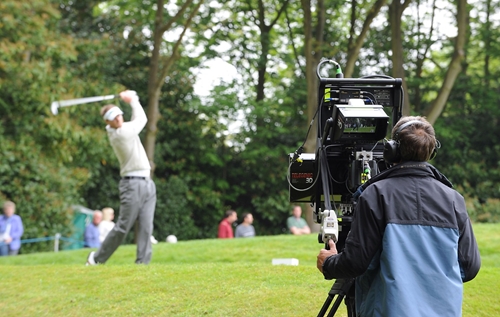The world of broadcast television has dramatically changed in recent years. Viewers are increasingly tossing away their old CRTs in favor of television sets capable of displaying high-definition video. With HDTV becoming the standard format for this medium, broadcasters have had to rethink the way they capture video feeds. Consumers expect crystal-clear, crisp images from their TV stations regardless of their size and market footprint. This means that both major broadcasters and their local affiliates need to have the requisite hardware to capture high-quality video that provides a great deal of detail.
That need to display the highest quality video possible has led broadcasters to embrace the 4K video format. Capable of displaying horizontal resolution on the order of 4,000 pixels, 4K stands as the current high-water mark for video in this industry. TV Technology contributor Ned Soltz explained that while television crews initially used 4K primarily to shoot sporting events, the format has become much more popular for other uses, with many of the latest major network programs utilizing it. NBC's "The Blacklist" and "The Michael J. Fox Show," for instance, both record uncompressed, raw video in 4K.
Capturing sports in high-quality video
Sporting events continue to drive interest in this format, though, allowing broadcasters to display more detail and recreate the stadium experience as closely as possible. Many sports ranging from basketball to hockey have benefited from this leap in video accuracy, making the games easier to follow for fans at home. The nation's most widely viewed television event – the Super Bowl – utilized 4K hardware to great effect. According to the source, FOX Sports placed 4K-enabled cameras around MetLife Stadium to capture the Seattle Seahawks' dominant victory in full detail. A camera was even attached to a blimp hovering overhead to provide another high-quality perspective.
The sports broadcaster is "finding the tools that are best in breed to utilize 4K in a production aspect that will exceed expectations," said Sports EVS America vice president James Stellpflug. "From camera to replay server to whatever device they're using – zooming and scaling extraction is part of that effort – bringing speed and quality to their Super Bowl production."
The benefits of Blackmagic equipment
Blackmagic cameras stand as some of the premiere devices capable of capturing 4K video without compromising quality or detail. This hardware has been used by various organizations to shoot everything from commercials to independent films because of their track record of quality performance. Getting the most value out of these devices will require users to incorporate a reliable SSD, however. Shooting and recording raw video places a great strain on a crew's equipment, necessitating that filmmakers only use the best hardware available. That is why these media professionals should not settle for anything less than an SSD specifically designed for video editing. If film crews do not incorporate SSD drives that match the quality and performance of their Blackmagic cameras, their video-capturing capabilities will inevitably suffer.
When choosing an SSD for video editing, it's important that filmmakers and broadcasters find a solution that has been built from the ground up to accommodate Blackmagic architecture. DIGISTOR's Professional Video Series SSD drives, for instance, are compatible with Blackmagic's exFAT format straight out of the box, eliminating unnecessary configuration-related headaches. Meanwhile, off-the-shelf options – even those approved for Blackmagic use – may not be able to keep up with the technology's rapid rate of change, leaving them vulnerable to obsolescence down the road.
Blackmagic goes to Hollywood
Blackmagic equipment allows even aspiring filmmakers to get the same playback quality as their major studio counterparts. One of the core benefits of the Blackmagic product line is the ability to record and touch up video in a manner that would otherwise require camera crews to spend thousands of dollars on production and editing equipment. With a little effort, independent directors can wring every detail and hue out of their raw video by shooting with Blackmagic.
In a profile featured on Blackmagic Design's website, filmmaker Samuel Jacob described how these products allowed him to achieve professional-level quality with his video capture without the backing of a studio. As an independent artist, Jacob is responsible for every phase of the filmmaking process, including covering the director, editor and colorist roles. With film or even DSLR formats, he would be unable to obtain the professional look and feel he wanted in his movie while investing a great deal of personal funding. By using Blackmagic cameras, Jacob has been able to shoot in high-quality raw video without having to break the bank on expensive equipment.
"[Blackmagic video playback is] so film-like that you don't even realize you're shooting on a digital camera," Jacob said. "This camera is made for independent filmmakers like me. … "I don't want the footage to simply stand out. I want something that will last, and Blackmagic Design delivers."
Moving forward, consumers will increasingly expect their video entertainment to be displayed in high-quality playback. To meet this demand, broadcasters of every size must have equipment capable of capturing clear and highly detailed video. By pairing a Blackmagic camera with an SSD for video editing, these professionals can achieve that level of quality without breaking the bank on new, overly expensive equipment.
"The wider availability of 4K cameras and compatible software coupled with new delivery technologies is not only accelerating the pace of 4K production but also showing that it is the direction of production," Soltz wrote. "It's not a fad or just a technology curiosity. 4K is here to stay."


Recent Comments